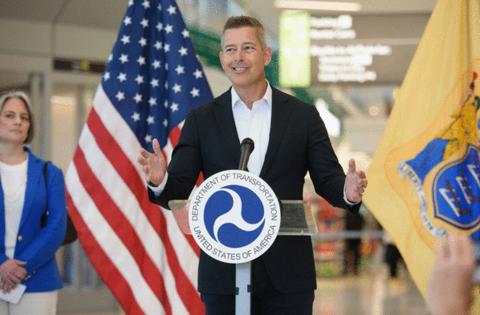Newark Airport opens a third runway, but will that end the delays and cancellations?
Published in News & Features
Newark Airport’s third runway reopened ahead of schedule Monday, increasing the capacity of the beleaguered transit hub amid staffing and technical concerns that have led to widespread cancellations and delays over the last several weeks.
In announcing the opening Monday, Transportation Secretary Sean Duffy told reporters improvements were also underway to improve the systems and personnel problems that have been at the heart of the crisis. That includes new transmission lines for critical radar feeds and the training of new air traffic controllers.
“Today we’re celebrating the opening of Newark’s runway,” Duffy said. “This is a 60-day project that actually was completed 13 days early.”
The north-south facing Runway 4L/22R — one of two parallel runways that serve the bulk of Newark’s passenger traffic — had been closed in April for routine maintenance. The closure came just weeks before a radar outage that precipitated a staffing shortage — a trifecta of maladies that lead to a May meltdown for New Jersey travelers.
Newark Airport has been operating at a capacity of 56 flights per hour — 28 arrivals and 28 departures — since 4L/22R closed in April. The runway was open for departures on Monday, and Duffy said the FAA is expected to certify electrical equipment on the runway by early next week, which would clear it for arriving flights as well.
After that certification, the airport will be authorized see as many as 68 flights an hour — a number Duffy said the airport could support with the current staffing level of air traffic controllers.
But Newark’s problems over the past few months have had less to do with one fewer runway, and more to do with a shortage of air traffic controllers amid a spate of technical failures.
The troubles came to a head on April 28, when the radar coverage of the North Jersey airspace and the telecommunications lines between the controllers and the local airport towers failed.
The outage effectively blinded air traffic controllers at Philadelphia’s “terminal radar approach control” — or TRACON — who are responsible for the skies over north Jersey. Twenty percent of the controllers assigned to the Newark airspace took a leave of absence over the incident — a leave that is expected to last two more weeks.
Alongside the staffing issues, radar problems have persisted.
Until last year, New York TRACON — located in Nassau County — controlled the skies for all three major NYC airports: Newark, LaGuardia and JFK.
That changed in July 2024, when the FAA gave control of the North Jersey airspace — and the two dozen air traffic controllers who were certified on it — to Philadelphia TRACON in an attempt to more evenly distribute the workload at the chronically understaffed Long Island control center.
But despite the reassignment, the radar feeds that the North Jersey airspace controllers rely on are still sent to New York TRACON. From there they must be sent on to Philadelphia along old copper telecom lines — a situation that introduces latency into the system and can cause outages.
Duffy said Monday that work was underway to try to solve both the staffing and technical issues that have plagued Newark.
A new fiber optic line has already been run between Philly TRACON and the New York facility, Duffy said, installed by Verizon “in less than a month’s time.”
“That new fiber line’s not stood up yet because we’re testing it,” he said. “The FAA has some pretty laborious testing procedures — we appreciate that.”
“Our hope is, at the end of June [or] early July, we can switch it over [to the fiber optic cable,]” Duffy said.
A spokesperson for Verizon did not immediately respond to a request for comment.
Duffy acknowledged that six of the 22 controllers assigned to Philly TRACON are currently on leave, leaving just 16 to manage the north Jersey skies.
Duffy said there are 22 additional controllers currently being trained to take up roles at the Philadelphia facility. Of those, 14 are controllers certified to manage other air-spaces around the country. Eight are new controllers in training.
“It does take time,” Duffy said.
“You want to make sure you have well-trained, certified controllers controlling your air space,” he said, adding that he expected them to come online within the year.
A spokesman for the National Air Traffic Controllers Association did not immediately respond to a request for comment.
©2025 New York Daily News. Visit at nydailynews.com. Distributed by Tribune Content Agency, LLC.







Comments